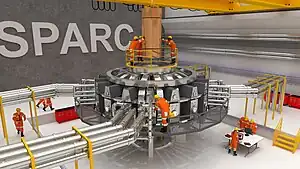SPARC (tokamak)
SPARC is a tokamak under development by Commonwealth Fusion Systems (CFS) in collaboration with the Massachusetts Institute of Technology (MIT) Plasma Science and Fusion Center (PSFC).[1] Funding has come from Eni,[2] Breakthrough Energy Ventures, Khosla Ventures, Temasek, Equinor, Devonshire Investors, and others.[3][4][5]
| Soonest/Smallest Possible ARC | |
|---|---|
 | |
| Device type | Tokamak |
| Location | Devens, Massachusetts, United States |
| Affiliation | Commonwealth Fusion Systems MIT Plasma Science and Fusion Center |
| Technical specifications | |
| Major radius | 1.85 m |
| Minor radius | 0.57 m |
| Plasma volume | 20 m3 |
| Magnetic field | 12.2 T |
| Heating power | 25 MW |
| Fusion power | (140 MW) |
| Discharge duration | (10 s) |
| Plasma current | (8.7 MA) |
| Plasma temperature | (80×106 K) |
| History | |
| Date(s) of construction | 2021–2025 |
| Year(s) of operation | 2025 (projected; first plasma) |
SPARC plans to verify the technology and physics required to build a power plant based on the ARC fusion power plant concept.[6] SPARC is designed to achieve this with margin in excess of breakeven and may be capable of achieving up to 140 MW of fusion power for 10 second bursts despite its relatively compact size.[2][6]
The project is on schedule for operation in 2025[7][8] after completing a magnet test in 2021.[9][10]
History
The SPARC project was announced in 2018 with a planned completion in 2025.[7] In March 2021, CFS announced that it planned to build SPARC at its campus in Devens, Massachusetts.[11]
In September 2021 the project successfully tested a prototype high-field coil, achieving a record for high-temperature superconducting magnets, with a field strength of 20 T at the temperature of 20 K.[12]
Technology
SPARC uses yttrium barium copper oxide (YBCO) high-temperature superconducting magnets that retain superconductivity at temperatures as high as 77 K (optimally at 10 K).[13] The resulting plasmas are expected to generate at least twice as much energy as is required to sustain themselves at high temperatures (200 million K),[14] giving a fusion gain Q > 2, with an expected Q ≈ 11.[6]
References
- Creely, A. J.; Greenwald, M. J.; Ballinger, S. B.; Brunner, D.; Canik, J.; Doody, J.; Fülöp, T.; Garnier, D. T.; Granetz, R.; Gray, T. K.; Holland, C. (2020). "Overview of the SPARC tokamak". Journal of Plasma Physics. 86 (5): 865860502. Bibcode:2020JPlPh..86e8602C. doi:10.1017/S0022377820001257. ISSN 0022-3778.
- "MIT and newly formed company launch novel approach to fusion power". MIT News. Massachusetts Institute of Technology. Retrieved 2018-06-15.
- Rathi, Akshat. "In search of clean energy, investments in nuclear-fusion startups are heating up". Quartz. Retrieved 2020-09-29.
- Commonwealth Fusion Systems. "Commonwealth Fusion Systems Raises $115 Million and Closes Series A Round to Commercialize Fusion Energy". www.prnewswire.com (Press release). Retrieved 2020-09-29.
- Commonwealth Fusion Systems. "Commonwealth Fusion Systems Raises $84 Million in A2 Round". www.prnewswire.com (Press release). Retrieved 2020-10-05.
- Creely, A. J.; Greenwald, M. J.; Ballinger, S. B.; Brunner, D.; Canik, J.; Doody, J.; Fülöp, T.; Garnier, D. T.; Granetz, R.; Gray, T. K.; Holland, C. (2020). "Overview of the SPARC tokamak". Journal of Plasma Physics. 86 (5). Bibcode:2020JPlPh..86e8602C. doi:10.1017/S0022377820001257. ISSN 0022-3778.
- "Commonwealth Fusion Systems raises $115m". The Boston Globe. Retrieved 2022-03-05.
- Lavars, Nick (2021-09-09). "World's strongest fusion magnet brings new power to nuclear pursuit". New Atlas. Retrieved 2021-09-09.
- "Validating the physics behind the new MIT-designed fusion experiment". MIT News. Massachusetts Institute of Technology. Retrieved 2020-09-30.
- Fountain, Henry (2020-09-29). "Compact Nuclear Fusion Reactor Is 'Very Likely to Work,' Studies Suggest". The New York Times. ISSN 0362-4331. Retrieved 2020-09-29.
- Chesto, Jon (2021-03-03). "MIT energy startup homes in on fusion, with plans for 47-acre site in Devens". The Boston Globe. Retrieved 2021-03-03.
- "MIT-designed project achieves major advance toward fusion energy". MIT News. Massachusetts Institute of Technology. Retrieved 2021-09-09.
- Clery, Daniel (2021-03-03). "Fusion startup plans reactor with small but powerful superconducting magnets". Science. AAAS. Retrieved 2021-06-14.
- "MIT Validates Science Behind New Nuclear Fusion Reactor Design". www.greentechmedia.com. Archived from the original on 22 October 2020.